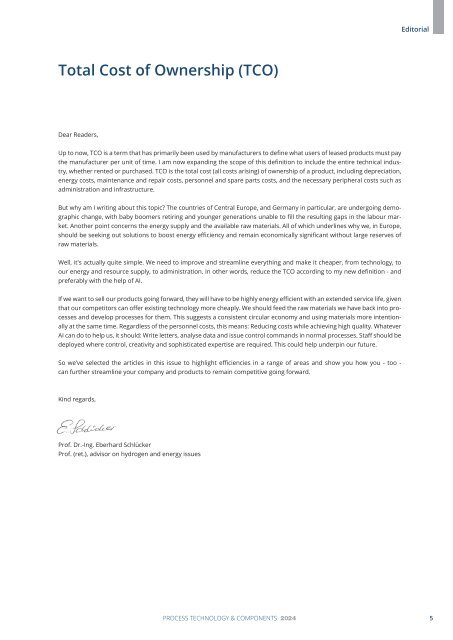PuK - Process Technology & Components 2024
A technical trade magazine with a history of more than 60 years.
A technical trade magazine with a history of more than 60 years.
Create successful ePaper yourself
Turn your PDF publications into a flip-book with our unique Google optimized e-Paper software.
Editorial<br />
Total Cost of Ownership (TCO)<br />
Dear Readers,<br />
Up to now, TCO is a term that has primarily been used by manufacturers to define what users of leased products must pay<br />
the manufacturer per unit of time. I am now expanding the scope of this definition to include the entire technical industry,<br />
whether rented or purchased. TCO is the total cost (all costs arising) of ownership of a product, including depreciation,<br />
energy costs, maintenance and repair costs, personnel and spare parts costs, and the necessary peripheral costs such as<br />
administration and infrastructure.<br />
But why am I writing about this topic? The countries of Central Europe, and Germany in particular, are undergoing demographic<br />
change, with baby boomers retiring and younger generations unable to fill the resulting gaps in the labour market.<br />
Another point concerns the energy supply and the available raw materials. All of which underlines why we, in Europe,<br />
should be seeking out solutions to boost energy efficiency and remain economically significant without large reserves of<br />
raw materials.<br />
Well, it's actually quite simple. We need to improve and streamline everything and make it cheaper, from technology, to<br />
our energy and resource supply, to administration. In other words, reduce the TCO according to my new definition - and<br />
preferably with the help of AI.<br />
If we want to sell our products going forward, they will have to be highly energy efficient with an extended service life, given<br />
that our competitors can offer existing technology more cheaply. We should feed the raw materials we have back into processes<br />
and develop processes for them. This suggests a consistent circular economy and using materials more intentionally<br />
at the same time. Regardless of the personnel costs, this means: Reducing costs while achieving high quality. Whatever<br />
AI can do to help us, it should: Write letters, analyse data and issue control commands in normal processes. Staff should be<br />
deployed where control, creativity and sophisticated expertise are required. This could help underpin our future.<br />
So we’ve selected the articles in this issue to highlight efficiencies in a range of areas and show you how you - too -<br />
can further streamline your company and products to remain competitive going forward.<br />
Kind regards,<br />
Prof. Dr.-Ing. Eberhard Schlücker<br />
Prof. (ret.), advisor on hydrogen and energy issues<br />
PROCESS TECHNOLOGY & COMPONENTS <strong>2024</strong><br />
5

















